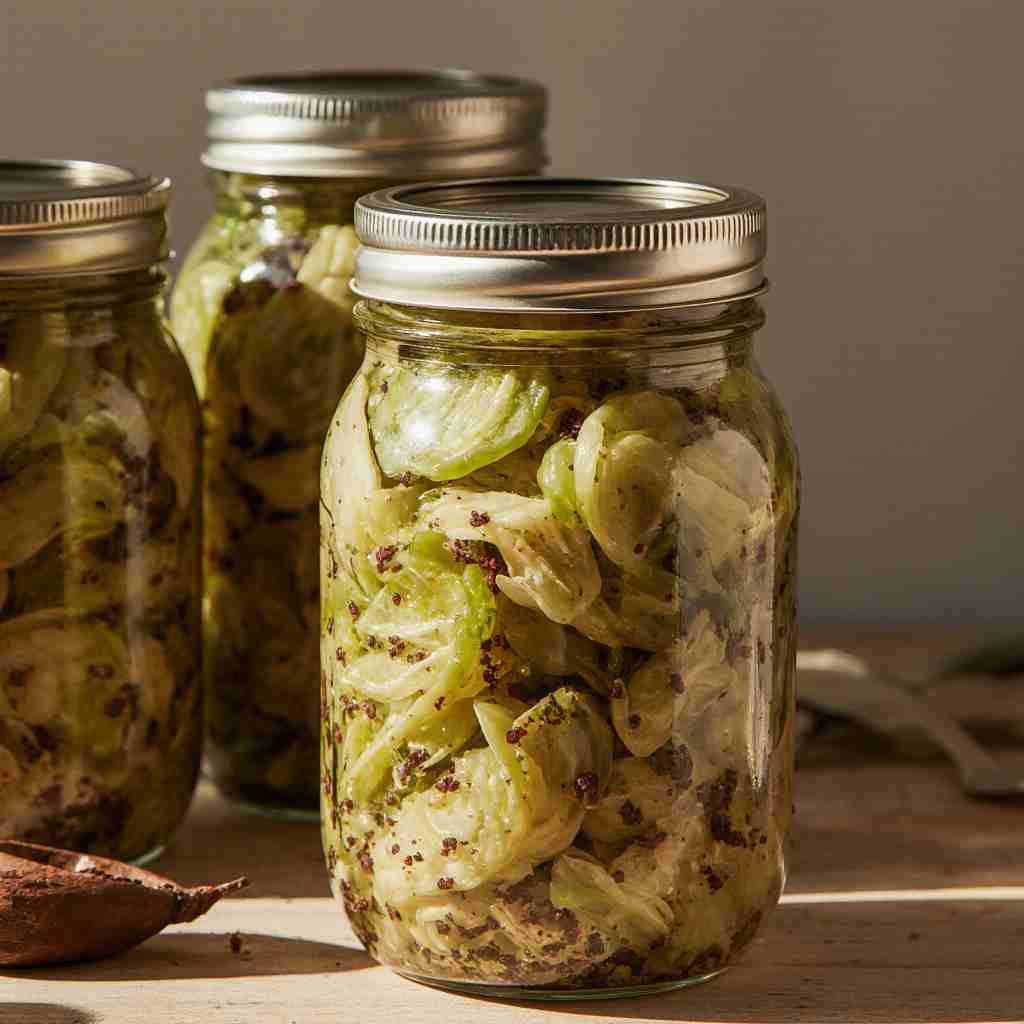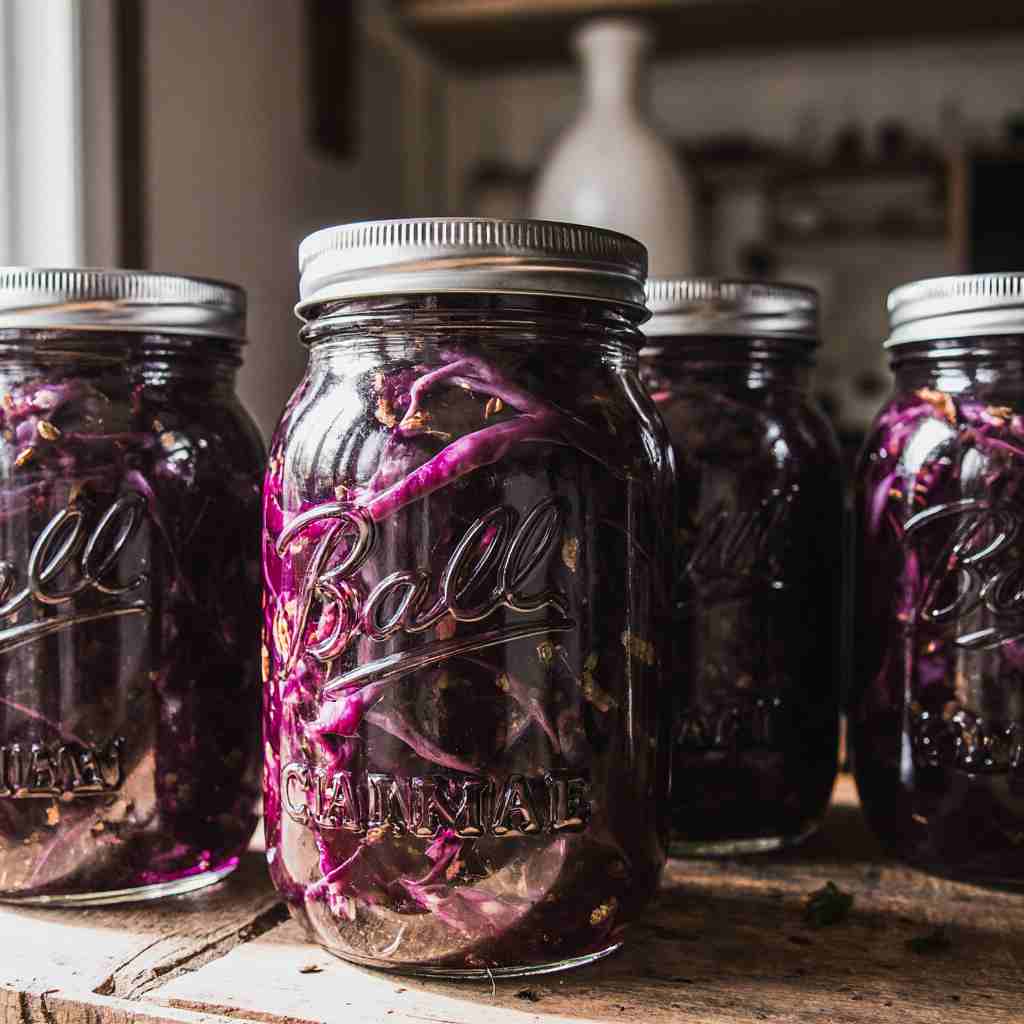Looking for a way to preserve that delicious cabbage harvest or simply love the tangy, crispness of pickled veggies? This Canning Pickled Cabbage – Quick European-Style Recipe is exactly what you need! It’s a simple, safe, and incredibly flavorful way to create a shelf-stable condiment that adds a vibrant kick to countless meals. Forget store-bought sauerkraut; this homemade version bursts with fresh flavor and a delightful crunch.
Jump To :
What is Canning Pickled Cabbage?
Canning Pickled Cabbage is a method of preserving thinly sliced cabbage in a vinegar-based brine. This recipe takes inspiration from traditional European pickling methods, resulting in a tangy, slightly sweet, and utterly addictive condiment. Unlike fermented sauerkraut, this pickled cabbage uses vinegar for its preservation, making it a quick and easy process. The heat from canning ensures a shelf-stable product, allowing you to enjoy your pickled cabbage long after the cabbage season has ended.
It’s a fantastic way to use up excess cabbage from your garden or simply enjoy a unique and flavorful addition to your pantry. This recipe provides a crisp, crunchy texture and a balanced sweet and sour flavor that will elevate your dishes. If you are a busy person, you can quickly finish it at home with very simple steps. Let’s dive in and learn how to make this amazing pickle today!
Key Ingredients for Canning Pickled Cabbage:
- 4 lbs Cabbage: Green or red cabbage works well. Finely shredded is best. Remove the outer leaves and core the cabbage before shredding.
- 1 large Onion: Yellow or white onion, thinly sliced.
- 1 large Carrot: Peeled and thinly sliced.
- 2 cups White Vinegar (5% acidity): This is crucial for the pickling process and ensures proper preservation.
- 1 cup Granulated Sugar: Balances the acidity and adds a touch of sweetness. You can adjust this to your liking.
- 2 tablespoons Pickling Salt or Sea Salt: Do not use iodized table salt, as it can cloud the brine and affect the flavor.
- 1 tablespoon Mustard Seeds: Adds a pungent and slightly spicy flavor.
- 1 teaspoon Celery Seeds: Contributes a subtle, earthy flavor.
- 1 teaspoon Black Peppercorns: Adds a touch of spice and complexity.
- 1/2 teaspoon Turmeric Powder (optional): Adds a beautiful yellow color and a hint of earthy flavor.
- Water: As needed to cover the vegetables in the brine.
How to Make Canning Pickled Cabbage:
This European-style Canning Pickled Cabbage is a relatively straightforward pickling recipe, perfect for beginners and seasoned canners alike. It takes about 1 hour and 15 minutes, including prep and processing time.
The combination of simple ingredients creates a tangy, slightly sweet, and incredibly versatile condiment. It’s crunchy, flavorful, and a fantastic addition to sandwiches, salads, and countless other dishes. Let’s learn how to make this delicious treat!
Preparation time : 30 minutes
Processing time : 15 minutes
Yields : Approximately 6-8 pint jars, depending on cabbage density.
Step-by-Step Instructions:
- Prepare the Jars and Lids: Wash canning jars, lids, and bands in hot, soapy water. Rinse well. Keep jars hot until ready to use. You can sterilize them by boiling them for 10 minutes, or running them through a hot cycle in the dishwasher. keep clean until further using of other steps.
- Shred the Vegetables: Shred the cabbage finely using a mandoline, food processor, or a sharp knife. Thinly slice the onion and carrot.
- Combine Vegetables: In a large bowl, combine the shredded cabbage, sliced onion, and sliced carrot. Toss to mix evenly.
- Prepare the Brine: In a large stainless steel saucepan, combine the white vinegar, sugar, pickling salt, mustard seeds, celery seeds, black peppercorns, and turmeric powder (if using).
- Bring to a Boil: Bring the brine to a rolling boil over medium-high heat, stirring until the sugar and salt are completely dissolved.
- Pack the Jars: Pack the vegetable mixture tightly into the hot, sterilized jars, leaving 1/2 inch headspace. Use a non-metallic spatula or bubble remover to press down firmly and remove any air pockets.
- Pour the Brine: Carefully ladle the hot brine over the vegetables in each jar, maintaining the 1/2 inch headspace. Ensure the vegetables are fully submerged in the brine.
- Remove Air Bubbles: Use a non-metallic utensil (like a plastic knife or bubble remover) to gently run along the inside of the jars to release any trapped air bubbles.
- Wipe the Rims: Wipe the rims of the jars with a clean, damp cloth to remove any brine residue. This ensures a proper seal.
- Place Lids and Bands: Place the sterilized lids on the jars, then screw on the bands until fingertip tight (not too tight; you want air to be able to escape during processing).
- Process in a Boiling Water Bath: Lower the filled jars into a boiling water bath canner using jar lifters. Ensure the jars are completely covered with at least 1 inch of water.
- Process for 15 Minutes: Bring the water to a rolling boil and process the jars for 15 minutes. Adjust processing time based on your altitude (add 5 minutes for 1,001-3,000 feet, 10 minutes for 3,001-6,000 feet, and 15 minutes for 6,001-8,000 feet).
- Remove and Cool: Turn off the heat and carefully remove the jars from the canner using jar lifters. Place them on a towel-lined surface, allowing for air circulation.
- Check the Seals: Let the jars cool completely for 12-24 hours. After they have cooled, check the seals by pressing down on the center of each lid. If the lid doesn’t flex or pop back up, the jar is properly sealed. Improperly sealed jars should be refrigerated and eaten within a few weeks, or reprocessed with a new lid.
- Store: Store the sealed jars in a cool, dark, dry place for at least 2 weeks before opening, to allow the flavors to meld. Canned pickled cabbage is best consumed within 1 year for optimal quality.
Why You’ll Love This Canning Pickled Cabbage:
The main highlight of this Canning Pickled Cabbage recipe is its delightful balance of sweet and sour flavors, paired with an irresistible crunch. The quick pickling process and canning make it a convenient way to preserve cabbage, ensuring you have a tangy condiment ready whenever you need it. Another reason to love this recipe is the cost-saving benefits of making it at home. You can buy cabbage in bulk or use homegrown cabbage, saving money compared to purchasing commercially pickled products. Plus, you have full control over the ingredients, ensuring a high-quality and preservative-free product.
The mustard and celery seeds, along with the option of adding turmeric, create a complex and aromatic flavor profile that elevates the cabbage beyond a simple side dish. It’s perfect on sausages, in reubens, or as a vibrant addition to any charcuterie board. If you enjoy the traditional sauerkraut, you should this pickled version. Try it now!
What to Serve Pickled Cabbage With:
This Canning Pickled Cabbage is incredibly versatile and pairs well with a variety of dishes. Here are a few ideas:
- Sandwiches & Wraps: Add it to Reubens, pulled pork sandwiches, or grilled cheese for a tangy crunch.
- Sausages & Bratwurst: A classic pairing! The acidity of the cabbage cuts through the richness of the meat.
- Salads: Mix it into potato salad, coleslaw, or a simple green salad for added flavor and texture.
- Charcuterie Boards: Include it as a flavorful element alongside cheeses, meats, and crackers.
- Pork Dishes: Serve it as a side dish with roasted pork loin, pork chops, or ham.
- Pierogies & Dumplings: A great accompaniment to these Eastern European specialties.
- Eggs: Add it to omelets, frittatas, or scrambled eggs for a unique flavor.
Top Tips for Perfecting Canning Pickled Cabbage

- Use Fresh, High-Quality Cabbage: The fresher the cabbage, the better the flavor and texture of the finished product.
- Don’t Use Iodized Salt: Iodized table salt can cloud the brine and affect the pickling process. Always use pickling salt or sea salt.
- Pack Jars Tightly: Packing the jars tightly helps prevent excess air pockets and ensures the cabbage is well submerged in the brine.
- Maintain Proper Headspace: Leaving 1/2 inch of headspace is crucial for proper sealing.
- Ensure Jars are Completely Submerged: Make sure the jars are completely covered with water during the boiling water bath process.
- Check Seals Properly: After the jars have cooled, check the seals by pressing down on the center of the lid. If it’s properly sealed, the lid shouldn’t flex or pop back up.
- Adjust Sugar to Your Taste: If you prefer a less sweet pickle, reduce the amount of sugar slightly.
- Add Other Spices: Feel free to experiment with other spices, such as caraway seeds, juniper berries, or red pepper flakes.
- Don’t Double the Recipe Without Testing: While you can scale the recipe, always test a small batch first to ensure the flavors remain balanced.
Storing and Reheating Tips:
- Storing: Store properly sealed jars of Canning Pickled Cabbage in a cool, dark, and dry place. A pantry or basement is ideal. Once opened, refrigerate the jar and consume within 2-3 weeks. Storing in the right condition, it can stay fresh for even a year.
- Freezing: Freezing is not recommended for this recipe. Freezing can alter the texture of the cabbage, making it mushy and less appealing.
- Reheating: Reheating is typically not necessary for pickled cabbage, as it is meant to be enjoyed cold or at room temperature as a condiment or side dish. However, if you prefer to warm it slightly, you can gently heat it in a saucepan over low heat or microwave it for a short time. Be careful not to overheat it, as this can affect the texture and flavor.
Final Thoughts:
Canning Pickled Cabbage is a fantastic way to preserve the flavors of summer or simply enjoy a tangy and crunchy condiment any time of year. This recipe is easy to follow, safe for home canning, and offers a delicious twist on traditional sauerkraut. With its versatility and delightful flavor, this pickled cabbage is sure to become a staple in your kitchen.
Read More also:
- Canning Apple Jelly
- Canning Pear Jelly
- Canning Mint Jelly
- Canning Hot Pepper Jelly
- Canning Mushroom Soup
- Canning Apricot Jam Recipe
- Canning Fig Jam Recipe
- Canning Plum Jam
- Our Pinterest
Canning Pickled Cabbage FAQs:
Q: Can I use red cabbage instead of green cabbage?
A: Yes, you can substitute red cabbage for green cabbage. It will give the pickled cabbage a beautiful purple color. The taste will be slightly different but still delicious.
Q: Can I reduce the amount of sugar in the recipe?
A: Yes, you can adjust the amount of sugar to your liking. Start by reducing it by 1/4 cup and taste. You can always add more if needed.
Q: Can I use apple cider vinegar instead of white vinegar?
A: Yes, but the flavor will be different. Apple cider vinegar will impart a slightly sweeter and more complex flavor.
Q: How long do I need to wait before opening the jars?
A: It’s best to wait at least 2 weeks before opening the jars to allow the flavors to meld.
Q: What if my jars don’t seal properly?
A: If a jar doesn’t seal properly, refrigerate it immediately and use it within a few weeks. You can also reprocess it with a new lid.
Q: Can I add other vegetables to the pickled cabbage?
A: Yes, you can experiment with adding other vegetables, such as bell peppers, cauliflower, or cucumbers. Just be sure to maintain the overall ratio of vegetables to brine.

